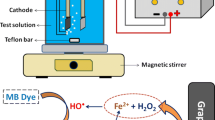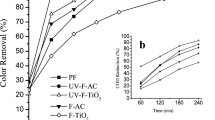Abstract
Diversity and rapidly multiplication of the pollutants incite as to improve the conventional treatments wastewater methods. One of the bottlenecks often faced is the presence into wastewater of organic pollutants with complex structures that requests the design of efficient processes. Thus, this work investigates the removal of polyvinylamine sulfonate anthrapyridone (PSA) dye which complex structure makes difficult its degradation by conventional technologies. For that, a heterogeneous oxidative process using pyrite as sustainable catalyst was designed. Initially, the performance of the system BBD-carbon felt as anode and cathode, respectively for the production of H2O2 was determined in comparison with system boron-doped diamond nickel foam. The carbon felt electrode provided the highest oxidant production, and it was selected for the treatment of the polymeric dye. Several oxidative processes were evaluated, and the best degradation levels were obtained by application of electro-Fenton-pyrite process. In addition, it was determined that dye removal followed a kinetic model of pseudo-first-order achieving the highest efficiency by operation at optimum dosage of pyrite 2 g/L and 200 mA of current intensity. Depending on the optimal experimental conditions, these values lead to a nearly complete mineralization (total organic carbon removal of 95%) after 6 h. Furthermore, the reusability of pyrite was evaluated, by removal of PSA in four cycles.







Similar content being viewed by others
References
Ammar S, Oturan MA, Labiadh L, Guersalli A, Abdelhedi R, Oturan N, Brillas E (2015) Degradation of tyrosol by a novel electro-Fenton process using pyrite as heterogeneous source of iron catalyst. Water Res 74:77–87
Anipsitakis GP, Dionysiou DD (2004) Radical generation by the interaction of transition metals with common oxidants. Environ Sci Technol 38:3705–3712
Arienzo M (1999) Oxidizing 2,4,6-trinitrotoluene with pyrite-H2O2 suspensions. Chemosphere 39:1629–1638
Asma M, Oturan MA, Oturan N, Abdelhédi R, Ammar S (2014) Degradation of 2-nitrobenzoic acid by electrochemical advanced oxidation using a boron-doped diamond or platinum anode and a carbon felt cathode. Fresenius Environ Bull 23:199–206
Bae S, Kim D, Lee W (2013) Degradation of diclofenac by pyrite catalyzed Fenton oxidation. Appl Catal B Environ 134-135:93–102
Barhoumi N, Labiadh L, Oturan MA, Oturan N, Gadri A, Ammar S, Brillas E (2015) Electrochemical mineralization of the antibiotic levofloxacin by electro-Fenton-pyrite process. Chemosphere 141:250–257
Barhoumi N, Oturan N, Olvera-Vargas H, Brillas E, Gadri A, Ammar S, Oturan MA (2016) Pyrite as a sustainable catalyst in electro-Fenton process for improving oxidation of sulfamethazine. Kinetics, mechanism and toxicity assessment. Water Res 94:52–61
Becelic-Tomin M, Dalmacija B, Rajic L, Tomasevic D, Kerkez D, Watson M, Prica M (2014) Degradation of anthraquinone dye reactive blue 4 in pyrite ash catalyzed fenton reaction. Sci World J 2014:1–8
Bocos E, Pazos M, Sanromán MA (2014) Electro-Fenton decolourization of dyes in batch mode by the use of catalytic activity of iron loaded hydrogels. J Chem Technol Biotechnol 89:1235–1242
Bocos E, Iglesias O, Pazos M, Ángeles Sanromán M (2016a) Nickel foam a suitable alternative to increase the generation of Fenton’s reagents. Process Saf Environ Prot 101:34–44
Bocos E, Pazos M, Sanromán MA (2016b) Electro-Fenton treatment of imidazolium-based ionic liquids: kinetics and degradation pathways. RSC Adv 6:1958–1965
Bounab L, Iglesias O, González-Romero E, Pazos M, Ángeles Sanromán M (2015) Effective heterogeneous electro-Fenton process of m-cresol with iron loaded actived carbon. RSC Adv 5:31049–31056
Brillas E, Sirés I, Oturan MA (2009) Electro-Fenton process and related electrochemical technologies based on Fenton’s reaction chemistry. Chem Rev 109:6570–6631
Chaplin BP (2014) Critical review of electrochemical advanced oxidation processes for water treatment applications. Environ Sci Processes Impacts 16:1182–1203
Cheng T, Huang C, Huang Y, Shih Y (2017) Kinetic study and optimization of electro-Fenton process for dissolution and mineralization of ion exchange resins. Chem Eng J 308:954–962
Cohn CA, Mueller S, Wimmer E, Leifer ND, Greenbaum S, Strongin DR, Schoonen MAA (2006) Pyrite-induced hydroxyl radical formation and its effect on nucleic acids. Geochem Trans 7:3
Cruz-Rizo A, Gutiérrez-Granados S, Salazar R, Peralta-Hernández JM (2017) Application of electro-Fenton/BDD process for treating tannery wastewaters with industrial dyes. Sep Purif Technol 172:296–302
Dirany A, Sirés I, Oturan N, Özcan A, Oturan MA (2012) Electrochemical treatment of the antibiotic sulfachloropyridazine: kinetics, reaction pathways, and toxicity evolution. Environ Sci Technol 46:4074–4082
Duan X, Ao Z, Sun H, Indrawirawan S, Wang Y, Kang J, Liang F, Zhu ZH, Wang S (2015) Nitrogen-doped graphene for generation and evolution of reactive radicals by metal-free catalysis. ACS Appl Mater Interfaces 7:4169–4178
Fernández de Dios MÁ, Rosales E, Fernández-Fernández M, Pazos M, Sanromán MÁ (2015) Degradation of organic pollutants by heterogeneous electro-Fenton process using Mn-alginate composite. J Chem Technol Biotechnol 90:1439–1447
Garcia-Segura S, Brillas E (2011) Mineralization of the recalcitrant oxalic and oxamic acids by electrochemical advanced oxidation processes using a boron-doped diamond anode. Water Res 45:2975–2984
Graham AM, Bouwer EJ (2012) Oxidative dissolution of pyrite surfaces by hexavalent chromium: surface site saturation and surface renewal. Geochim Cosmochim Acta 83:379–396
Guelfi DRV, Gozzi F, Sirés I, Brillas E, Machulek A Jr, de Oliveira SC (2016) Degradation of the insecticide propoxur by electrochemical advanced oxidation processes using a boron-doped diamond/air-diffusion cell. Environ Sci Pollut Res 24:6083–6095 1–13
Guivarch E, Trevin S, Lahitte C, Oturan MA (2003) Degradation of azo dyes in water by electro-Fenton process. Environ Chem Lett 1:38–44
Gupta VK, Ali I, Saleh TA, Nayak A, Agarwal S (2012) Chemical treatment technologies for waste-water recycling—an overview. RSC Adv 2:6380–6388
Hammami S, Bellakhal N, Oturan N, Oturan MA, Dachraoui M (2008) Degradation of Acid Orange 7 by electrochemically generated •OH radicals in acidic aqueous medium using a boron-doped diamond or platinum anode: a mechanistic study. Chemosphere 73:678–684
Hammouda SB, Fourcade F, Assadi A, Soutrel I, Adhoum N, Amrane A, Monser L (2016) Effective heterogeneous electro-Fenton process for the degradation of a malodorous compound, indole, using iron loaded alginate beads as a reusable catalyst. Appl Catal B Environ 182:47–58
Hao F, Guo W, Lin X, Leng Y, Wang A, Yue X, Yan L (2014) Degradation of Acid Orange 7 in aqueous solution by dioxygen activation in a pyrite/H2O/O2 system. Environ Sci Pollut Res 21:6723–6728
Iglesias O, de Dios MAF, Tavares T, Sanromán MA, Pazos M (2015) Heterogeneous electro-Fenton treatment: preparation, characterization and performance in groundwater pesticide removal. J Ind Eng Chem 27:276–282
Khataee A, Gholami P, Sheydaei M (2016) Heterogeneous Fenton process by natural pyrite for removal of a textile dye from water: effect of parameters and intermediate identification. J Taiwan Inst Chem Eng 58:366–373
Labiadh L, Oturan MA, Panizza M, Hamadi NB, Ammar S (2015) Complete removal of AHPS synthetic dye from water using new electro-fenton oxidation catalyzed by natural pyrite as heterogeneous catalyst. J Hazard Mater 297:34–41
Lin H, Zhang H, Wang X, Wang L, Wu J (2014) Electro-fenton removal of Orange II in a divided cell: reaction mechanism, degradation pathway and toxicity evolution. Sep Purif Technol 122:533–540
Lin H, Oturan N, Wu J, Sharma VK, Zhang H, Oturan MA (2017) Removal of artificial sweetener aspartame from aqueous media by electrochemical advanced oxidation processes. Chemosphere 167:220–227
Matta R, Hanna K, Chiron S (2007) Fenton-like oxidation of 2,4,6-trinitrotoluene using different iron minerals. Sci Total Environ 385:242–251
Meijide J, Gómez J, Pazos M, Sanromán MA (2016) Degradation of thiamethoxam by the synergetic effect between anodic oxidation and Fenton reactions. J Hazard Mater 319:43–50
Mousset E, Oturan N, van Hullebusch ED, Guibaud G, Esposito G, Oturan MA (2014) Influence of solubilizing agents (cyclodextrin or surfactant) on phenanthrene degradation by electro-Fenton process—study of soil washing recycling possibilities and environmental impact. Water Res 48:306–316
Nidheesh PV (2015) Heterogeneous Fenton catalysts for the abatement of organic pollutants from aqueous solution: a review. RSC Adv 5:40552–40577
Nidheesh PV, Gandhimathi R (2012) Trends in electro-Fenton process for water and wastewater treatment: an overview. Desalination 299:1–15
Nidheesh PV, Gandhimathi R, Ramesh ST (2013) Degradation of dyes from aqueous solution by Fenton processes: a review. Environ Sci Pollut Res 20:2099–2132
Nidheesh PV, Gandhimathi R, Velmathi S, Sanjini NS (2014) Magnetite as a heterogeneous electro Fenton catalyst for the removal of Rhodamine B from aqueous solution. RSC Adv 4:5698–5708
Oturan MA (2000) Ecologically effective water treatment technique using electrochemically generated hydroxyl radicals for in situ destruction of organic pollutants: application to herbicide 2,4-D. J Appl Electrochem 30:475–482
Oturan MA, Aaron J (2014) Advanced oxidation processes in water/wastewater treatment: principles and applications. A review. Crit Rev Environ Sci Technol 44:2577–2641
Özcan A, Oturan MA, Oturan N, Sahin Y (2009) Removal of Acid Orange 7 from water by electrochemically generated Fenton's reagent. J Hazard Mater 163:1213–1220
Peydayesh M, Kazemi P, Bandegi A, Mohammadi T, Bakhtiari O (2015) Treatment of bentazon herbicide solutions by vacuum membrane distillation. J Water Process Eng 8:e17–e22
Pignatello JJ, Oliveros E, MacKay A (2006) Advanced oxidation processes for organic contaminant destruction based on the fenton reaction and related chemistry. Crit Rev Environ Sci Technol 36:1–84
Rosales E, Pazos M, Longo MA, Sanromán MA (2009) Electro-Fenton decoloration of dyes in a continuous reactor: a promising technology in colored wastewater treatment. Chem Eng J 155:62–67
Rosales E, Pazos M, Sanromán MA (2011) Comparative efficiencies of the decolourisation of leather dyes by enzymatic and electrochemical treatments. Desalination 278:312–317
Schoonen MAA, Harrington AD, Laffers R, Strongin DR (2010) Role of hydrogen peroxide and hydroxyl radical in pyrite oxidation by molecular oxygen. Geochim Cosmochim Acta 74:4971–4987
Sellers RM (1980) Spectrophotometric determination of hydrogen peroxide using potassium titanium (IV) oxalate. Analyst 105:950–954
Sirés I, Garrido JA, Rodríguez RM, Brillas E, Oturan N, Oturan MA (2007) Catalytic behavior of the Fe3+/Fe2+ system in the electro-Fenton degradation of the antimicrobial chlorophene. Appl Catal B Environ 72:382–394
Sirés I, Brillas E, Oturan MA, Rodrigo MA, Panizza M (2014) Electrochemical advanced oxidation processes: today and tomorrow. A review. Environ Sci Pollut Res 21:8336–8367
Solano AMS, Martínez-Huitle CA, Garcia-Segura S, El-Ghenymy A, Brillas E (2016) Application of electrochemical advanced oxidation processes with a boron-doped diamond anode to degrade acidic solutions of Reactive Blue 15 (Turqueoise Blue) dye. Electrochim Acta 197:210–220
Sun L, Li Y, Li A (2015) Treatment of actual chemical wastewater by a heterogeneous fenton process using natural pyrite. Int J Environ Res Public Health 12:13762–13778
Vasudevan S, Oturan MA (2014) Electrochemistry: as cause and cure in water pollution-an overview. Environ Chem Lett 12:97–108
Wu D, Feng Y, Ma L (2013) Oxidation of azo dyes by H2O2 in presence of natural pyrite. Water Air Soil Pollut 224:1–11
Yao Y, Chen H, Qin J, Wu G, Lian C, Zhang J, Wang S (2016) Iron encapsulated in boron and nitrogen codoped carbon nanotubes as synergistic catalysts for Fenton-like reaction. Water Res 101:281–291
Zhang Y, Zhang K, Dai C, Zhou X, Si H (2014) An enhanced Fenton reaction catalyzed by natural heterogeneous pyrite for nitrobenzene degradation in an aqueous solution. Chem Eng J 244:438–445
Zhang P, Yuan S, Liao P (2016) Mechanisms of hydroxyl radical production from abiotic oxidation of pyrite under acidic conditions. Geochim Cosmochim Acta 172:444–457
Acknowledgements
Spanish Ministry of Economy and Competitiveness (MINECO), Xunta de Galicia, and ERDF Funds under projects CTM2014-52471-R and GRC 2013/003 have financially supported this research.
Author information
Authors and Affiliations
Corresponding author
Additional information
Responsible editor: VÃtor Pais Vilar
Electronic supplementary material
ESM 1
(DOCX 280 kb).
Rights and permissions
About this article
Cite this article
Bouzayani, B., Meijide, J., Pazos, M. et al. Removal of polyvinylamine sulfonate anthrapyridone dye by application of heterogeneous electro-Fenton process. Environ Sci Pollut Res 24, 18309–18319 (2017). https://doi.org/10.1007/s11356-017-9468-5
Received:
Accepted:
Published:
Issue Date:
DOI: https://doi.org/10.1007/s11356-017-9468-5




